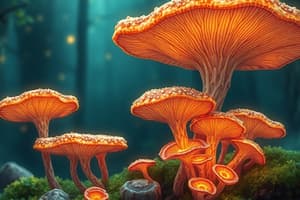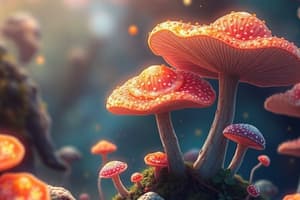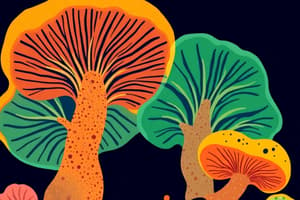Podcast
Questions and Answers
What percentage range of plant-based cellulose materials is composed of lignin?
What percentage range of plant-based cellulose materials is composed of lignin?
- 5-10%
- 30-50%
- 1-5%
- 10-30% (correct)
Which of the following is a white-rot fungus known for its ability to break down lignin?
Which of the following is a white-rot fungus known for its ability to break down lignin?
- Aspergillus niger
- Penicillium roqueforti
- Phanerochaete chrysosporium (correct)
- Gymnosporangium asiaticum
What environmental factors are most significant for the decomposition of lignin by white-rot fungi?
What environmental factors are most significant for the decomposition of lignin by white-rot fungi?
- Low nitrogen, high moisture, and high temperatures
- High acidity, low humidity, and cold temperatures
- Adequate nitrogen, moisture, and temperature (correct)
- Low oxygen, high salinity, and neutral temperature
Under what conditions was an increase in anaerobic digestibility of barley straw reported, after treatment with white-rot fungi?
Under what conditions was an increase in anaerobic digestibility of barley straw reported, after treatment with white-rot fungi?
What is the term for fungi that cause infectious diseases?
What is the term for fungi that cause infectious diseases?
What are virulence factors, in the context of fungal pathogens?
What are virulence factors, in the context of fungal pathogens?
What effect does Gymnosporangium asiaticum infection have on plant metabolism?
What effect does Gymnosporangium asiaticum infection have on plant metabolism?
What is the function of alkaloids produced by some endophytes within a plant?
What is the function of alkaloids produced by some endophytes within a plant?
What is the primary function of fungal fruiting bodies?
What is the primary function of fungal fruiting bodies?
What is the remarkable ability exhibited by 'Cordyceps' fungi?
What is the remarkable ability exhibited by 'Cordyceps' fungi?
What is the fundamental characteristic that classifies fungi as eukaryotic organisms?
What is the fundamental characteristic that classifies fungi as eukaryotic organisms?
Which of the following best describes the method of nutrition for the majority of fungi mentioned in the text?
Which of the following best describes the method of nutrition for the majority of fungi mentioned in the text?
What is the origin of fungal fruiting bodies?
What is the origin of fungal fruiting bodies?
Which of the following best describes the method of reproduction for Candida albicans?
Which of the following best describes the method of reproduction for Candida albicans?
What term best describes the relationship of Candida albicans with the human body when it does not cause disease?
What term best describes the relationship of Candida albicans with the human body when it does not cause disease?
Which of the following is a common manifestation of a Candida albicans overgrowth?
Which of the following is a common manifestation of a Candida albicans overgrowth?
What is the fundamental structural unit of filamentous fungi?
What is the fundamental structural unit of filamentous fungi?
Which of the following best describes the structure of a hyphum?
Which of the following best describes the structure of a hyphum?
Which of the following structures is unique to filamentous fungi?
Which of the following structures is unique to filamentous fungi?
Which of the following best describes the relationship between septa and hyphae?
Which of the following best describes the relationship between septa and hyphae?
Conidia are a type of:
Conidia are a type of:
Which of the following is NOT a typical method of growth for fungi?
Which of the following is NOT a typical method of growth for fungi?
What characteristic was used to identify the clonal colony of Armillaria solidipes in the Oregon forest?
What characteristic was used to identify the clonal colony of Armillaria solidipes in the Oregon forest?
The Armillaria solidipes fungus found in Oregon is notable for its:
The Armillaria solidipes fungus found in Oregon is notable for its:
Which of the following is a characteristic that distinguishes filamentous fungi from yeasts?
Which of the following is a characteristic that distinguishes filamentous fungi from yeasts?
Which of these statements is correct regarding Candida albicans?
Which of these statements is correct regarding Candida albicans?
Based on the content, what is the primary role of saprophytic fungi in an ecosystem?
Based on the content, what is the primary role of saprophytic fungi in an ecosystem?
Which of the following fungi is responsible for the potato blight disease?
Which of the following fungi is responsible for the potato blight disease?
What is the primary mode of transmission for Batrachochytrium dendrobatidis?
What is the primary mode of transmission for Batrachochytrium dendrobatidis?
What is the primary function of the enzyme ligninase, produced by Phanerochaete chrysosporium?
What is the primary function of the enzyme ligninase, produced by Phanerochaete chrysosporium?
Which of the following describes hyphae?
Which of the following describes hyphae?
Which group of fungi does the common edible mushroom, Agaricus spp., belong to?
Which group of fungi does the common edible mushroom, Agaricus spp., belong to?
Which of the following is a characteristic of the fungi mentioned in the text?
Which of the following is a characteristic of the fungi mentioned in the text?
Which of the following is an example of a yeast species?
Which of the following is an example of a yeast species?
What does a 'clonal colony' indicate, as exemplified by the Armillaria solidipes study?
What does a 'clonal colony' indicate, as exemplified by the Armillaria solidipes study?
Which of the following is a known human pathogen?
Which of the following is a known human pathogen?
What is the main role of fungi in the context of ecosystems?
What is the main role of fungi in the context of ecosystems?
Flashcards
What are fungi?
What are fungi?
Fungi are eukaryotic organisms that can be either single-celled (yeasts) or multicellular (molds). They reproduce through budding, hyphal growth, or spore production.
What is Armillaria solidipes?
What is Armillaria solidipes?
Armillaria solidipes, also known as the honey mushroom, is a parasitic fungus that can infect and kill trees. It's notable for forming massive underground networks.
What is the largest living organism?
What is the largest living organism?
The largest known individual organism is a single honey mushroom (Armillaria solidipes) found in Oregon, spanning over 2.4 miles.
What is Candida albicans?
What is Candida albicans?
Signup and view all the flashcards
What are lichens?
What are lichens?
Signup and view all the flashcards
What is chytridiomycosis?
What is chytridiomycosis?
Signup and view all the flashcards
What is Batrachochytridium dendrobatidis?
What is Batrachochytridium dendrobatidis?
Signup and view all the flashcards
Yeasts
Yeasts
Signup and view all the flashcards
Filamentous fungi
Filamentous fungi
Signup and view all the flashcards
Phytophthora infestans
Phytophthora infestans
Signup and view all the flashcards
Mucor sp.
Mucor sp.
Signup and view all the flashcards
Basidiomycetes
Basidiomycetes
Signup and view all the flashcards
Entoloma sinuatum
Entoloma sinuatum
Signup and view all the flashcards
Saccharomyces cerevisiae
Saccharomyces cerevisiae
Signup and view all the flashcards
Deuteromycetes
Deuteromycetes
Signup and view all the flashcards
Lignin
Lignin
Signup and view all the flashcards
White-rot fungi
White-rot fungi
Signup and view all the flashcards
Phanerochaete chrysosporium
Phanerochaete chrysosporium
Signup and view all the flashcards
Factors affecting lignin degradation
Factors affecting lignin degradation
Signup and view all the flashcards
Parasitic fungi
Parasitic fungi
Signup and view all the flashcards
Endophytes
Endophytes
Signup and view all the flashcards
Virulence factors
Virulence factors
Signup and view all the flashcards
Host-pathogen interactions
Host-pathogen interactions
Signup and view all the flashcards
Fruiting bodies in fungi
Fruiting bodies in fungi
Signup and view all the flashcards
Zombie fungi's impact on hosts
Zombie fungi's impact on hosts
Signup and view all the flashcards
Fungal characteristics
Fungal characteristics
Signup and view all the flashcards
Fungal nutrition types
Fungal nutrition types
Signup and view all the flashcards
Importance of habitat-specific fungal species
Importance of habitat-specific fungal species
Signup and view all the flashcards
Candida albicans
Candida albicans
Signup and view all the flashcards
Yeast Reproduction
Yeast Reproduction
Signup and view all the flashcards
Hyphum
Hyphum
Signup and view all the flashcards
Mycelia
Mycelia
Signup and view all the flashcards
Spores
Spores
Signup and view all the flashcards
Aspergillus fumigatus
Aspergillus fumigatus
Signup and view all the flashcards
Athlete's Foot
Athlete's Foot
Signup and view all the flashcards
Study Notes
Fungi Overview
- Fungi are eukaryotic, multicellular organisms.
- Growth varies between species, with some reproducing through budding (like yeast) and others through hyphae or spores. Spores can travel long distances.
- Fungi play a role in breaking down dead organic matter (saprophytes) in a variety of ecosystems.
- Some fungi are parasitic, obtaining nutrients from living organisms.
- There are two main types of fungi: yeasts and filamentous fungi. Each type has a unique reproductive cycle.
- Examples of fungi include Candida albicans (causes thrush), Armillaria solidipes (the largest organism on Earth) and Trichophyton rubrum (causes athlete's foot).
- Fungi can be beneficial or detrimental to human health and the environment.
Learning Outcomes
- Understanding the basic cell biology of fungi, including distinctions between different types and their respective reproduction cycles.
- Learning examples of various fungi in relation to their habitats.
Fungal Classification
- Fungi are classified into yeasts and filamentous fungi.
- Examples of yeast species: Saccharomyces cerevisiae.
- Examples of filamentous species: Phanerochaete chrysosporium, Mucor sp., Phytophthora infestans, Agaricus spp., Entaloma sinuatum, and Trichophyton spp.
Fungal Nutrition
- Many fungi are saprophytes, meaning they decompose dead organic matter.
- Some fungi are parasitic, extracting nutrients from living organisms.
- Important enzymes produced by some fungi: ligninase (produced by Phanerochaete chrysosporium).
Plant-Fungi Interactions
- Some fungi live within plants, known as endophytes, and can be important in various plant-fungi interactions.
- Gymnosporangium asiaticum infection in plants alters plant metabolism.
Reproduction in Yeasts
- Yeasts reproduce via budding by vegetative outgrowth.
- The daughter cell is similar to, but smaller, than the parent cell.
Reproduction in Filamentous Fungi
- Producing spores and hyphae.
- Spores are dispersed by wind or animals.
- Hyphae are specialized filaments that enable the organism to spread and grow.
"Zombie Fungi"
- Fungi like Cordyceps can alter the behaviour of animals.
- They can manipulate insect behaviour to optimize spore dispersal.
Factors Affecting Lignin Degradation
- Adequate nitrogen, moisture, and temperature are crucial for white-rot fungal growth and lignin decomposition.
- Environmental conditions within host animal tissues are also significant for parasitic fungi.
Studying That Suits You
Use AI to generate personalized quizzes and flashcards to suit your learning preferences.




